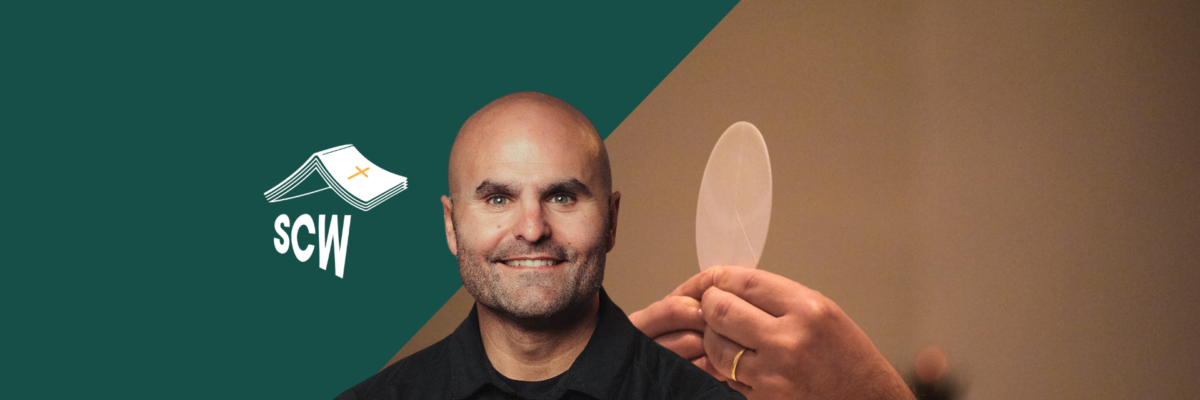
Episode 101: Year B – 30th Sunday of Ordinary Time
In this episode, we look at one detail from the second reading, taken from Hebrews 5:1-6, and the whole of the Gospel reading, which recounts the story of Jesus healing the blind Bartimaeus, recorded in Mark 10:46-52. The apologetical topic that relates to the detail in the second reading is the nature of the Mass as the Sacrifice of Christ. The topic of focus for the Gospel is the historicity of Jesus as a healer.
Readings: Click Here
Looking for Sunday Catholic Word Merchandise? Look no further! Click Here
Hey everyone,
Welcome to The Sunday Catholic Word, a podcast where we reflect on the upcoming Sunday Mass readings and pick out the details that are relevant for explaining and defending our Catholic faith.
I’m Karlo Broussard, staff apologist and speaker for Catholic Answers, and the host for this podcast.
In this episode, we’re going to look at one detail from the second reading, taken from Hebrews 5:1-6, and the whole of the Gospel reading, which recounts the story of Jesus healing the blind Bartimaeus, recorded in Mark 10:46-52. The apologetical topic that relates to the detail in the second reading is the nature of the Mass as the Sacrifice of Christ. The topic of focus for the Gospel is the historicity of Jesus as a healer.
Let’s start with the second reading, again, taken from Hebrews 5:1-6
Every high priest is taken from among men
and made their representative before God,
to offer gifts and sacrifices for sins.
He is able to deal patiently with the ignorant and erring,
for he himself is beset by weakness
and so, for this reason, must make sin offerings for himself
as well as for the people.
No one takes this honor upon himself
but only when called by God,
just as Aaron was.
In the same way,
it was not Christ who glorified himself in becoming high priest,
but rather the one who said to him:
You are my son:
this day I have begotten you;
just as he says in another place:
You are a priest forever
according to the order of Melchizedek.
The detail that I want to highlight is the author’s statement that “Every high priest is taken from among men . . . to offer gifts and sacrifices for sins.” This same author says the same thing in Hebrews 8:3: “For every high priest is appointed to offer gifts and sacrifices.”
But in Hebrews 8, the author makes this claim in association with another truth and then makes a further implication. In verses 1-2, he writes, “[W]e have such a high priest, one who is seated at the right hand of the throne of the Majesty in heaven, 2 a minister in the sanctuary and the true tent which is set up not by man but by the Lord.” In verse 3, the author draws out an implication from the two truths that Jesus is our high priest in the heavenly sanctuary and that every high priest must have a gift to offer, writing, “hence it is necessary for this priest also to have something to offer.”
This gives rise to the question: “Which sacrifice for sins could Jesus possibly offer in the heavenly sanctuary?” Surely, it can’t be a sacrifice other than his own body and blood, since the author already told us that his sacrifice is sufficient and offered once and for all. Hebrews 7:27 reads, “He has no need, like those high priests, to offer sacrifices daily, first for his own sins and then for those of the people; he did this once for all when he offered up himself.”
The only explanation as to which sacrifice Jesus presents to the Father in the heavenly sanctuary is his very own body and blood, the one sacrifice of Calvary. And that offering is made in an unbloody manner.
You’ve probably already intuited the apologetical significance: this is the theology of the Sacrifice of the Mass. The Mass is the making present of the single offering of Christ on calvary in an unbloody manner. This is exactly what Christ does in the heavenly sanctuary.
So, any Protestant who has a problem with the theology of the Mass is going to have a problem with the author of Hebrews’ theology of Christ’ high priestly ministry in the heavenly sanctuary, since they are both and the same: the one sacrifice of Christ presented to the Father in an unbloody manner.
Let’s now turn to the Gospel, which, again, is the story of Jesus healing the blind Bartimaeus. Here’s what we read:
As Jesus was leaving Jericho with his disciples and a sizable crowd,
Bartimaeus, a blind man, the son of Timaeus,
sat by the roadside begging.
On hearing that it was Jesus of Nazareth,
he began to cry out and say,
“Jesus, son of David, have pity on me.”
And many rebuked him, telling him to be silent.
But he kept calling out all the more,
“Son of David, have pity on me.”
Jesus stopped and said, “Call him.”
So they called the blind man, saying to him,
“Take courage; get up, Jesus is calling you.”
He threw aside his cloak, sprang up, and came to Jesus.
Jesus said to him in reply, “What do you want me to do for you?”
The blind man replied to him, “Master, I want to see.”
Jesus told him, “Go your way; your faith has saved you.”
Immediately he received his sight
and followed him on the way.
There’s no one detail that I want to focus on in this Gospel reading. Rather, the whole narrative is our focus, particularly its historicity.
Whenever we’re talking about whether the Gospel portrait of Jesus as a healer is historically reliable, there are different approaches that we can take. One approach is more general in nature, an approach where we highlight the multiple independent sources that attest to Jesus as a healer. The other approach is more specific, where we look at specific healing narratives and the details that support its historicity. That’s what I want to do with this narrative of the healing of Bartimaeus.
The first thing to note about the narrative is the few Semitic details, which reveal a connection to the early Palestinian community. For historians, such Semitic details are an indication of historicity.
One detail is the use of the Aramaic word Rabbouni, which translates as “Master.” It also includes “Son of David,” which is a title that is not found in the earliest Christian community, and thus probably dates to the time of Jesus’ ministry.
The historicity of this healing miracle is further supported by details that don’t serve any apologetical or catechetical purposes. For example, Mark names the recipient of the miracle (“Bartimaeus”), he ties the named individual to a geographical place (the “roadside” outside Jericho), he marks the point of Jesus’ ministry when the healing takes place (on his way up to Jerusalem for his passion and death—Mark 10:32), and he marks the time of the miracle: shortly before Passover (cf. Mark 14:1).
These details strongly suggest that the story comes from an eyewitness. How else would they be known? And according to John P. Meier, it’s probable that the eyewitness was Bartimaeus himself.
New Testament scholar Richard Bauckham, in his book Jesus and the Eyewitnesses, supports this thesis by arguing it’s likely the reason the names of figures like Bartimaeus were preserved in the Gospels was that they became members of the Christian community and served as the primary tradition bearer for these events.
This rings true. If someone encountered Jesus, and the Christians never heard from that person again, it’s unlikely that person’s name would have been remembered and passed down. For example, the name of the father of the possessed boy whom Jesus exorcised in Luke 9:40-44 wasn’t preserved, unlike Jairus, whose name was preserved. It’s likely the boy’s father didn’t join the Christian community, whereas Jairus did.
But in the case of Bartimaeus, seemingly he became a member of the Christian community and thus was the tradition bearer. This fits with what Mark tells us in Mark 10:52: After receiving his sight, Bartimaeus “followed [Jesus] on the way.”
Mark isn’t saying that Bartimaeus just followed Jesus down the street. Rather, he’s telling us that Bartimaeus became a member of the Christian community. “The way” was what the early Christians called themselves (see Acts 9:2; 19:9, 23; 24:14, 22).
Having an eyewitness of an event is great. But having the very person who was healed as a tradition bearer is even better, since it further ensures that the story won’t be tainted with legendary developments or fabrications.
The story of Bartimaeus is just one example among many where the narratives of Jesus’ healing miracles meet the historiographical criteria. We don’t have time to look at the others, but for now, suffice to say that when we combine the account of Jesus’ healing of Bartimaeus with the multiple attestation evidence of Jesus’ healing miracles throughout five out of the five independent Gospel sources and the non-narrative references, we have good reason to conclude that the New Testament portrait of Jesus as a miraculous healer is a portrait that dates back to the time of Jesus—this is what his earlier followers believed him to be.
This is just one example among many where the narratives of Jesus’ healing miracles meet the historiographical criteria, thereby providing historical grounds to affirm Jesus as a healer, and to provide reason to trust the reliability of the Gospel reports about Jesus.
Conclusion
Well, my friends, that brings us to the end of this episode of the Sunday Catholic Word. The readings for this upcoming 30th Sunday of Ordinary Time, Year B. The second reading and the Gospel reading gives us opportunity to reflect on
- The Sacrifice of the Mass,
- The historicity of the portrait of Jesus as a healer, and
- The historicity of the Gospels themselves.
As always, thank you for subscribing to the podcast. And please be sure to tell your friends about it and invite them to subscribe as well at sundaycatholicword.com. You might also want to check out the other great podcasts in our Catholic Answers podcast network: Trent Horn’s The Counsel of Trent, Joe Heschmeyer’s Shameless Popery, and Jimmy Akin’s A Daily Defense, and Tim Staples’ 1-on-1 with Tim, all of which can be found at catholic.com.
One last thing: if you’re interested in getting some cool mugs and stickers with my logo, “Mr. Sunday podcast,” go to shop.catholic.com.
I hope you have a blessed 30th Sunday of Ordinary Time, Year B. Until next time, God Bless!



